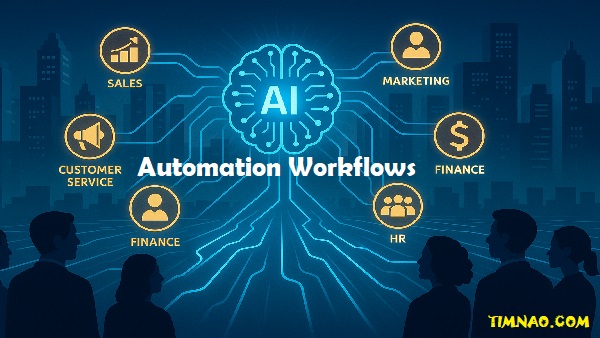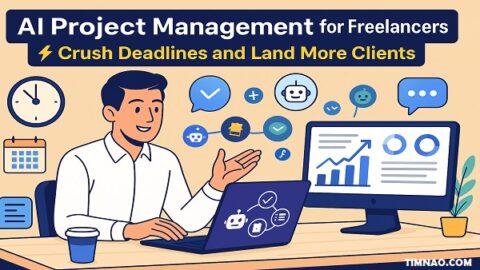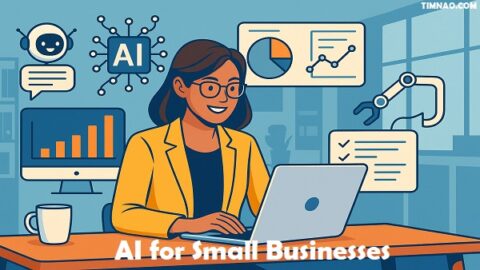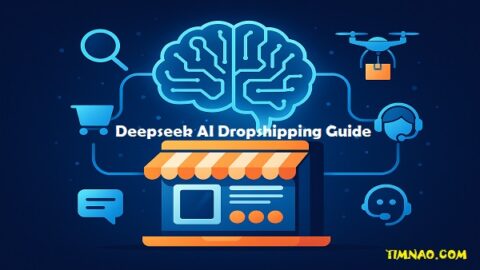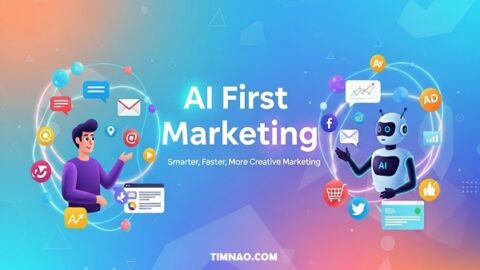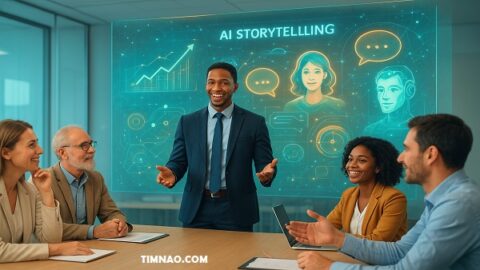✨ Unleash Incredible Growth: Your Ultimate Guide to AI Automation Workflows!
Welcome to an era where business growth isn’t just about working harder, but smarter. The integration of AI Automation Workflows is no longer a futuristic dream; it’s a present-day reality transforming how companies operate, compete, and expand. If you’re a beginner looking to understand how this technology can lead to automated business growth, you’re in the right place. This guide will demystify the concepts and show you how AI agents for business can become your most powerful allies.
Imagine offloading repetitive, time-consuming tasks to intelligent systems that work 24/7, error-free. Think about gaining deeper insights from your data, personalizing customer interactions at scale, and freeing up your team to focus on strategic initiatives. This is the promise of AI-powered automation – a pathway to enhanced productivity, reduced operational costs, and ultimately, remarkable business expansion.
Many businesses, especially smaller ones or those new to advanced technology, might find the idea of implementing AI daunting. However, the landscape of AI tools and platforms has become increasingly accessible. You don’t need to be a data scientist or a programming guru to start leveraging these powerful capabilities. This article will break down the essentials in an easy-to-understand manner.
We’ll explore what AI agents are, the role of automation platforms, and how different business functions – from sales and marketing to HR and finance – can be revolutionized. You’ll gain practical insights into identifying automation opportunities and taking your first steps towards building your own AI Automation Workflows. The goal is to equip you with the knowledge to confidently embrace this technology and unlock incredible, sustainable growth for your business.
🚀 Table of Contents
- 🧠 Understanding the Core Components of AI Automation
- 🤖 What Exactly Are AI Agents for Business?
- 🛠️ The Role of Automation Platforms
- 🔗 APIs: The Digital Handshake Enabling AI Automation Workflows
- 💼 Revolutionizing Business Operations with AI Automation Workflows
- 📈 Supercharging Your Sales and CRM with Intelligent Automation
- 🎯 Transforming Marketing and Advertising for Maximum Impact
- 🤝 Elevating Customer Support and Service to New Heights
- 🛒 Optimizing E-Commerce and Order Management Seamlessly
- 🧑💼 Streamlining Human Resources and Recruitment Processes
- 💰 Innovating Finance and Process Automation for Better Control
- 🌐 Enhancing Communication and Professional Networking
- 💡 Getting Started: Your First Steps into the World of AI Automation Workflows
- 🔍 Identifying Prime Opportunities for Automation
- 🔧 Selecting the Right Tools for Your AI Automation Journey
- ⚙️ Conceptualizing Your First AI Automation Workflow
- 🧪 The Crucial Role of Testing and Iteration
- 🔮 The Future is Automated: Embracing AI for Sustainable Business Growth
- 🌟 Long-Term Advantages of Adopting AI Automation
- 🚀 Staying Ahead of the Curve in a Dynamic Landscape
- 🛡️ Navigating Ethical Considerations in AI Automation
- 🏁 Conclusion: Your Journey to Automated Business Growth Starts Now!
🧠 Understanding the Core Components of AI Automation
Before diving into the specific applications, it’s crucial to grasp the fundamental elements that make AI Automation Workflows possible. These components work together, creating a synergistic effect that amplifies efficiency and intelligence within your business processes.
🤖 What Exactly Are AI Agents for Business?
At the heart of many modern automation solutions are AI agents for business. Think of an AI agent as a sophisticated software entity that uses artificial intelligence, particularly large language models (LLMs) like OpenAI’s GPT series, to perform tasks autonomously. These agents can understand, process, and generate human-like text, make decisions based on learned patterns, and interact with other software systems.
Unlike traditional automation which follows rigid, pre-programmed rules, AI agents bring a level of “agentic AI” – meaning they can exhibit more dynamic and adaptive behavior. They can analyze complex data, such as customer inquiries or sales leads, and decide on the best course of action. For instance, an AI agent could qualify a lead by understanding the nuances of a conversation, not just by checking if certain keywords are present.
These agents are designed to handle tasks like lead scoring, content generation, predictive analytics, and multi-channel communication. They can interpret data from various sources, such as emails, chat logs, or CRM entries, and then act upon that information, often by triggering other steps in an automated workflow. The power of AI agents for business lies in their ability to mimic human cognitive functions for specific, defined tasks, thereby scaling intelligence across your operations.
🛠️ The Role of Automation Platforms
While AI agents provide the intelligence, automation platforms provide the framework and connectivity to build and execute AI Automation Workflows. These platforms are designed to connect various apps and services, allowing data to flow seamlessly and actions to be triggered across different tools without manual intervention.
Popular automation platforms include tools like n8n (an open-source option), Zapier, and Make (formerly Integromat). These platforms typically offer a visual interface where users can design workflows by linking together different “nodes” or “modules” representing specific applications (e.g., Gmail, Google Sheets, Slack, HubSpot) and actions (e.g., send an email, add a row to a spreadsheet, post a message).
The beauty of these platforms is that they democratize automation. You can create complex sequences of tasks without writing extensive code. For example, a workflow could start with a new entry in a web form, then use an AI agent to analyze the entry, update a CRM, and finally send a notification to a sales team member – all orchestrated by the automation platform. They are the backbone for implementing practical AI Automation Workflows by handling the logic, data transfer, and execution of the automated processes.
🔗 APIs: The Digital Handshake Enabling AI Automation Workflows
Application Programming Interfaces, or APIs, are the unsung heroes that make most AI Automation Workflows possible. An API is essentially a set of rules and protocols that allows one piece of software to communicate and exchange data with another. When an automation platform connects to your Gmail, Salesforce, or an AI service like OpenAI’s, it’s using their respective APIs.
Think of an API as a waiter in a restaurant. You (the automation platform) tell the waiter (the API) what you want from the kitchen (the other software application, e.g., your CRM). The waiter then communicates your request to the kitchen, and brings back what you asked for (the data or confirmation of an action).
In the context of AI agents for business, APIs are crucial. An automation platform might use an API to send data from a customer email to an AI model for analysis. The AI model, via its API, then sends back its analysis (e.g., sentiment or lead score), which the platform can then use to trigger further actions through other APIs, like updating a Google Sheet or sending a Slack message. Understanding that APIs enable these integrations is key to appreciating the interconnectedness of modern digital tools and the feasibility of creating powerful, cross-application AI Automation Workflows.
💼 Revolutionizing Business Operations with AI Automation Workflows
The true power of AI Automation Workflows comes to life when applied to specific business functions. By integrating AI agents for business, companies can achieve unprecedented levels of efficiency, personalization, and data-driven decision-making, leading to significant automated business growth.
📈 Supercharging Your Sales and CRM with Intelligent Automation
Sales teams often grapple with repetitive tasks like lead qualification, data entry, and initial outreach. AI Automation Workflows can transform these processes, allowing sales professionals to focus on closing deals and building relationships.
Imagine a new lead comes in via WhatsApp or a website form. An AI agent can instantly engage the lead, ask qualifying questions, and analyze the responses to score the lead’s potential. This score, along with the lead’s details, can then be automatically updated in your CRM (like HubSpot or Salesforce) and a notification sent to the appropriate sales rep if the lead is “hot.” This ensures timely follow-up and prioritizes high-potential prospects.
Furthermore, AI can generate personalized follow-up emails or LinkedIn messages based on the lead’s profile and interactions. For B2B sales, AI can even monitor new leads in a CRM and initiate automated nurturing sequences with AI-generated content tailored to their industry and interests. This consistent, personalized engagement helps move leads through the sales funnel more effectively. AI can also assist in generating personalized ad copy for platforms like Google Ads and Facebook Ads, drawing from product details and target audience profiles to create high-converting advertisements. These are just a few examples of how AI Automation Workflows can significantly boost sales productivity and contribute to automated business growth.
Predictive analytics for sales is another burgeoning area. By analyzing historical sales data from platforms like Shopify, WooCommerce, or Magento, AI agents can predict upcoming sales trends and identify growth opportunities, helping businesses make proactive decisions to boost revenue.
🎯 Transforming Marketing and Advertising for Maximum Impact
Marketing departments can leverage AI Automation Workflows to create more targeted, efficient, and impactful campaigns. From content creation to ad management and audience engagement, AI is a game-changer.
Consider social media management. AI agents can generate engaging social media posts, complete with relevant AI-generated hashtags, and automatically publish them across platforms like Twitter, LinkedIn, and Instagram according to a schedule. This ensures a consistent online presence without manual effort. Beyond posting, AI can monitor brand mentions and analyze sentiment in real-time. If negative sentiment is detected, an alert can be sent to the marketing team for immediate attention, helping manage brand reputation proactively.
Content curation and newsletter personalization can also be automated. AI can fetch trending articles from RSS feeds or news APIs, summarize them, and personalize the content for different audience segments before auto-generating and sending a newsletter via services like Mailchimp or Gmail. This keeps your audience engaged with relevant information.
For paid advertising, AI Automation Workflows can optimize bids on Google Ads and Facebook Ads. By monitoring performance metrics like click-through rates (CTR), cost-per-click (CPC), and conversions, AI can analyze performance and recommend or even automatically update bid adjustments to improve return on investment (ROI). AI-powered SEO content optimization is another powerful application, where AI can fetch trending keywords from tools like SEMrush or Google Keyword Planner, generate SEO-optimized blog topics, and even analyze existing content for improvement suggestions. These intelligent automations help marketers maximize their reach and effectiveness, driving automated business growth.
Automated influencer marketing is also becoming a reality. AI can scan social platforms for suitable influencers, analyze their engagement and audience demographics, and even send out automated collaboration invites to those who qualify. Once campaigns are running, AI can track influencer performance and analyze ROI.
🤝 Elevating Customer Support and Service to New Heights
Customer support is a critical area where AI Automation Workflows can dramatically improve response times, efficiency, and customer satisfaction. AI agents for business are particularly adept at handling a large volume of inquiries and providing instant support.
AI-powered chatbots can be integrated with channels like WhatsApp, email, Facebook Messenger, or your website chat. These bots can understand customer inquiries in natural language, generate smart and contextually relevant responses, and resolve common issues instantly, 24/7. For more complex problems, the AI can escalate the ticket to a human agent, providing them with the conversation history for a seamless handover. This hybrid approach ensures that customers get quick help for simple issues while complex ones receive human attention.
Ticket management can also be optimized. When support tickets arrive via various channels, AI can analyze the content, determine the priority, and automatically route the ticket to the correct team or agent based on expertise (e.g., billing, technical support, sales). This reduces manual sorting and ensures tickets are handled by the most qualified person promptly. Notifications can be sent via Slack or email to keep teams informed.
Customer feedback analysis is another valuable application. AI can collect feedback from surveys, reviews, or social media, analyze the sentiment (positive, neutral, negative), and categorize the feedback. Insights can be logged into spreadsheets or dashboards, and alerts can be triggered for critical complaints that require immediate human intervention. This helps businesses quickly address concerns and identify areas for improvement, contributing to customer retention and loyalty – key factors in automated business growth.
🛒 Optimizing E-Commerce and Order Management Seamlessly
The e-commerce landscape is highly competitive, and AI Automation Workflows offer numerous ways to gain an edge, from product presentation to inventory control and fraud prevention. This leads to smoother operations and enhanced customer experiences, fueling automated business growth.
Generating compelling product descriptions can be a time-consuming task, especially for stores with large catalogs. AI agents can scrape new product details from e-commerce platforms like Shopify, WooCommerce, or Amazon, and then use AI (like ChatGPT) to generate unique, engaging, and SEO-optimized product descriptions. These descriptions can then be automatically updated on the store.
Competitor price monitoring is crucial for staying competitive. AI can scrape competitor websites for pricing data, analyze changes, and even recommend adjustments to your own pricing strategy. Alerts can be set up to notify you when a competitor lowers prices on key products, allowing for swift responses.
Predictive inventory management is another powerful use case. By analyzing historical sales data, AI can forecast future inventory demand for different products. This allows businesses to optimize stock levels, prevent stockouts of popular items, and avoid overstocking slow-moving ones. Automated restock alerts and even purchase order generation can be triggered when inventory levels fall below predicted needs. This ensures capital isn’t tied up unnecessarily and that customer demand can always be met.
Fraud detection is vital for protecting e-commerce businesses. AI can monitor incoming transactions from payment processors like Stripe or PayPal, analyze transaction patterns, and flag potentially fraudulent activities based on factors like transaction amount, location mismatches, or chargeback history. Suspicious transactions can be automatically blocked or held for review, and the finance team can be alerted immediately.
🧑💼 Streamlining Human Resources and Recruitment Processes
Human Resources and recruitment involve many administrative and repetitive tasks that can be significantly streamlined using AI Automation Workflows. This allows HR professionals to focus on more strategic aspects like employee development and engagement, while AI agents for business handle the groundwork.
Job candidate screening is a prime example. When applications come in through platforms like LinkedIn, Google Forms, or email, AI can parse resumes and application details. It can then rank candidates based on predefined criteria such as experience, skills, and job fit. These rankings and summaries can be automatically logged into a recruitment pipeline in Google Sheets or a dedicated Applicant Tracking System (ATS).
Automated resume screening takes this a step further. AI can analyze resumes in depth, identify key qualifications, and even flag candidates who are a strong match for a particular role. For top-ranked candidates, the system can automatically send out interview invitations with a link to a calendar booking system, speeding up the hiring process significantly.
Contract and proposal generation can also be automated. For freelancers, agencies, or even internal HR processes like generating employment contracts, AI can help. Details can be pulled from a form submission or CRM, and an AI agent can generate a customized contract or proposal based on a template. This document can then be saved as a PDF, sent to the relevant party via email, and the details logged.
Project task assignment within teams can also benefit from AI. When new tasks are created in project management tools like Trello, Asana, or ClickUp, AI can analyze the task requirements and assign it to the team member whose skills and current workload make them the best fit. Notifications about new assignments can then be sent via Slack or email, ensuring everyone stays informed and productive. These HR automations not only save time but also improve consistency and efficiency, contributing to overall automated business growth.
💰 Innovating Finance and Process Automation for Better Control
Financial processes are often data-intensive and require high accuracy, making them ideal candidates for AI Automation Workflows. Implementing AI agents for business in finance can lead to faster processing, reduced errors, and better financial visibility, which are crucial for automated business growth.
Automated invoice generation and payment reminders are a boon for many businesses. For recurring clients or project-based work, AI can integrate with accounting software like QuickBooks or even Google Sheets to generate invoices automatically. These invoices can then be dispatched via email or even WhatsApp. The system can also track payment statuses and send out automated reminders for unpaid or overdue invoices, improving cash flow.
Invoice processing and tax calculation can also be automated. When new transactions are fetched from platforms like Stripe, PayPal, or bank APIs, AI can help extract relevant data. For businesses dealing with various tax jurisdictions, AI can assist in calculating applicable taxes (like VAT, GST, or Sales Tax) based on predefined rules or even by analyzing transaction details. The finalized invoice details, including calculated taxes, can then be logged into accounting systems or spreadsheets.
AI-driven sales forecasting and revenue prediction provide valuable insights for financial planning. By analyzing past sales data from CRMs, payment gateways, or spreadsheets, AI models can predict future revenue trends. These forecasts can be generated on a regular basis (e.g., weekly or monthly) and shared with management via email or Slack reports, enabling more informed strategic decisions.
Affiliate marketing tracking and commission reporting can be a complex process, especially when dealing with multiple platforms and affiliates. AI Automation Workflows can track affiliate sales from various networks (Amazon, Shopify, ClickBank, etc.), calculate commission earnings based on predefined structures, and log this data into a central dashboard or spreadsheet. Automated reports can be sent to affiliates, and for more advanced setups, AI can even assist in automating payout approvals or flagging anomalies for review.
🌐 Enhancing Communication and Professional Networking
Effective communication and networking are vital for business development. AI Automation Workflows can help scale these efforts, making outreach more personalized and follow-ups more consistent, thereby supporting automated business growth.
Automated cold email outreach, when done responsibly and ethically, can be enhanced with AI. Instead of generic templates, AI agents can help generate personalized cold emails by scraping lead information from sources like LinkedIn, Google Sheets, or a CRM. The AI can tailor the message based on the lead’s name, company, industry, or recent activities. These personalized emails can then be sent via Gmail API or services like SendGrid, with follow-up sequences also managed by the automation.
LinkedIn is a primary platform for professional networking and lead generation. AI agents for business can assist in automating parts of this process. This could involve sending automated connection requests (ideally with a personalized note generated by AI) to a targeted list of professionals. Once a connection is made, a personalized follow-up message, also potentially drafted or enhanced by AI, can be sent to initiate a conversation. Responses and interactions can be logged in a CRM or spreadsheet for further action.
AI-powered competitor analysis and trend tracking extend beyond just pricing. AI can monitor competitor mentions across various social media platforms (Twitter, Instagram, Reddit), news sites, and forums. It can analyze the sentiment of these mentions (positive, neutral, negative) and generate trend reports on competitor reputation or product launches. This helps businesses stay informed about the competitive landscape and identify potential opportunities or threats quickly. Alerts can be set up for significant changes in competitor activity or sentiment.
Furthermore, AI can assist in managing brand reputation by performing sentiment analysis on mentions of your own brand across the web. This involves monitoring social media, review sites, and forums. Alerts can be configured to notify PR or customer support teams immediately in case of negative mentions, allowing for swift responses and damage control. These communication and networking automations help businesses build stronger relationships and stay ahead in their respective markets.
💡 Getting Started: Your First Steps into the World of AI Automation Workflows
Embarking on your AI Automation Workflows journey might seem complex, but by breaking it down into manageable steps, even beginners can start harnessing the power of AI agents for business for automated business growth.
🔍 Identifying Prime Opportunities for Automation
The first step is to pinpoint tasks within your business that are ripe for automation. Look for processes that are:
- Repetitive and Time-Consuming: Tasks like data entry, sending standard email responses, or manually updating spreadsheets are often excellent candidates.
- Rule-Based (Even with Some Complexity): While AI can handle nuances, processes with a discernible logic or decision tree are easier to automate initially.
- Prone to Human Error: Automation can improve accuracy in tasks like data transfer or calculations.
- Scalability-Dependent: If a process becomes a bottleneck as your business grows, automation can help.
- Data-Intensive: Tasks involving collecting, processing, or analyzing large volumes of data can benefit greatly from AI.
Walk through your daily operations in different departments. Where do your teams spend a lot of time on manual work that doesn’t require high-level strategic thinking? For example, in customer service, it might be answering FAQs. In sales, it could be initial lead data entry. In marketing, it could be scheduling social media posts. Make a list of these potential areas.
🔧 Selecting the Right Tools for Your AI Automation Journey
Once you’ve identified tasks, you’ll need the right tools. Your toolkit will typically consist of:
- An Automation Platform: As discussed earlier, tools like n8n, Zapier, or Make provide the environment to build and run your workflows. Consider factors like ease of use (especially visual builders for beginners), the range of supported app integrations, pricing, and whether you prefer a cloud-based or self-hosted solution (like n8n can be).
- AI Services/APIs: For tasks requiring intelligence, you’ll need access to AI models. OpenAI’s API for GPT models is a popular choice for natural language processing, content generation, and analysis. Other specialized AI APIs exist for vision, speech, etc.
- The Apps You Already Use: Your existing CRM (e.g., HubSpot, Salesforce), email marketing tools (e.g., Mailchimp), communication platforms (e.g., Slack, Gmail), e-commerce platforms (e.g., Shopify), and spreadsheets (e.g., Google Sheets) will be integral parts of your workflows. Ensure your chosen automation platform can connect to them.
Start small. You don’t need to invest in every tool at once. Many platforms offer free tiers or trials, allowing you to experiment.
⚙️ Conceptualizing Your First AI Automation Workflow
With a task and tools in mind, sketch out your first workflow. Think in terms of triggers, actions, and data flow:
- Trigger: What starts the workflow? (e.g., a new email received, a form submitted, a new row in a Google Sheet, a scheduled time).
- Actions: What steps need to happen? This is where AI agents for business might come in. (e.g.,
- Fetch data from the trigger.
- Send data to an AI model for analysis/generation.
- Receive AI output.
- Update a CRM record.
- Send a notification to Slack.
- Add a row to another Google Sheet.)
- Data Mapping: How does information from one step pass to the next? (e.g., the customer’s email from a form submission becomes the recipient in an automated email).
For example, a simple first workflow could be:
- Trigger: New lead captured in a Google Form.
- Action 1 (AI): Send lead details (e.g., budget, needs) to an OpenAI model to score the lead (Hot, Warm, Cold).
- Action 2: Add the lead and their AI-generated score to a “Leads” Google Sheet.
- Action 3 (Conditional): If the score is “Hot,” send an email notification to the sales manager.
This conceptual outline is the blueprint for building the workflow in your chosen automation platform.
🧪 The Crucial Role of Testing and Iteration
No AI Automation Workflow is perfect from the start. Rigorous testing is essential. Run test data through your workflow to ensure:
- Connectivity: All apps are correctly connected and authorized.
- Data Flow: Information is passing between steps as expected.
- Logic: Any conditional steps (if/then logic) are working correctly.
- AI Agent Performance: The AI model is providing accurate and useful outputs based on your prompts and data.
- Error Handling: What happens if a step fails? Does the workflow stop, or can it retry or notify you?
Once live, monitor its performance. Are there bottlenecks? Is the AI making mistakes? Are there opportunities to refine the prompts given to the AI for better results? Automation is not a “set it and forget it” solution, especially with AI involved. Regular review and iteration are key to optimizing your AI Automation Workflows and ensuring they continue to drive automated business growth effectively. Don’t be afraid to tweak prompts, adjust logic, or even swap out tools as you learn and as your business needs evolve.
🔮 The Future is Automated: Embracing AI for Sustainable Business Growth
The journey into AI Automation Workflows is more than just adopting new tools; it’s about cultivating a mindset of continuous improvement and embracing technology to achieve sustainable automated business growth. As AI agents for business become more sophisticated and accessible, their role in shaping the future of work will only expand.
🌟 Long-Term Advantages of Adopting AI Automation
The benefits of integrating AI into your business processes extend far beyond immediate efficiency gains. Over the long term, businesses that strategically implement AI Automation Workflows can expect:
- Enhanced Scalability: Automation allows you to handle increasing volumes of work—be it customer inquiries, sales leads, or data processing—without a proportional increase in manual labor or costs. This is fundamental for sustainable growth.
- Improved Decision-Making: AI agents can analyze vast datasets to uncover insights, predict trends, and provide recommendations that humans might miss. This data-driven approach leads to more informed strategic decisions across all business functions.
- Increased Innovation: By automating routine tasks, you free up your human workforce to focus on higher-value activities such as innovation, creative problem-solving, and strategic planning. This fosters a more dynamic and forward-thinking company culture.
- Better Customer Experiences: AI enables hyper-personalization at scale, from tailored marketing messages and product recommendations to instant customer support. This leads to increased customer satisfaction, loyalty, and lifetime value.
- Competitive Advantage: Businesses that effectively leverage AI automation can operate more efficiently, respond faster to market changes, and offer superior value to their customers, giving them a significant edge over competitors who are slower to adapt.
- Reduced Operational Costs: While there might be an initial investment, the long-term savings from reduced manual effort, fewer errors, optimized resource allocation, and improved efficiency can be substantial.
🚀 Staying Ahead of the Curve in a Dynamic Landscape
The field of artificial intelligence is evolving at an astonishing pace. New models, tools, and techniques emerge regularly. To ensure your AI Automation Workflows continue to deliver optimal results and contribute to automated business growth, it’s important to stay informed and adaptable.
This involves:
- Continuous Learning: Encourage your team to learn about new AI trends and automation possibilities. Follow industry publications, attend webinars, and explore new tools.
- Regularly Reviewing Workflows: What works today might not be the most efficient solution tomorrow. Periodically assess your existing automations to identify areas for improvement or opportunities to incorporate newer AI capabilities.
- Experimentation: Don’t be afraid to pilot new AI applications in controlled environments. Small experiments can lead to significant breakthroughs in efficiency and effectiveness.
- Focusing on Integration: The future will likely see even deeper integration of AI across all business systems. Prioritize tools and platforms that offer robust API support and can seamlessly connect with your existing and future technology stack.
- Data Strategy: AI thrives on data. Ensure you have good data governance practices in place. High-quality, well-organized data will fuel more powerful and accurate AI agents for business.
By fostering a culture of agility and continuous improvement, your business can not only implement effective AI Automation Workflows today but also adapt and thrive as AI technology continues to reshape the business world.
🛡️ Navigating Ethical Considerations in AI Automation
As businesses increasingly rely on AI Automation Workflows and AI agents for business, it’s crucial to be mindful of the ethical implications. Responsible AI implementation builds trust with customers, employees, and the wider community.
Key considerations include:
- Data Privacy and Security: AI systems often process sensitive customer and business data. Ensure robust security measures are in place and that data usage complies with privacy regulations like GDPR or CCPA. Be transparent with customers about how their data is being used.
- Bias and Fairness: AI models learn from the data they are trained on. If this data contains historical biases, the AI can perpetuate or even amplify them in its decisions (e.g., in recruitment screening or loan applications). Actively work to identify and mitigate bias in your AI systems.
- Transparency and Explainability: While some AI models are “black boxes,” strive for transparency in how AI-driven decisions are made, especially when they significantly impact individuals. If an AI denies a customer a service, for example, there should be a way to understand why.
- Impact on Employment: While AI automation aims to augment human capabilities and handle repetitive tasks, there are concerns about job displacement. Focus on upskilling and reskilling your workforce to work alongside AI, focusing on roles that require uniquely human skills like creativity, critical thinking, and empathy.
- Accountability: Ultimately, humans must remain accountable for the actions and decisions of AI systems deployed within their business. Establish clear lines of responsibility and oversight for your AI Automation Workflows.
Addressing these ethical considerations proactively will not only ensure compliance but also enhance your brand’s reputation as a responsible and trustworthy organization in the age of AI-driven automated business growth.
🏁 Conclusion: Your Journey to Automated Business Growth Starts Now!
The world of AI Automation Workflows is vast and full of potential. From streamlining daily tasks with intelligent AI agents for business to unlocking new avenues for automated business growth, the opportunities are immense, especially for those willing to learn and adapt. As a beginner, the key is to start small, focus on clear use cases, and gradually expand your use of this transformative technology.
We’ve journeyed through the core components of AI automation, explored its revolutionary impact across various business functions, and outlined practical steps to get you started. Remember, the goal isn’t to replace human ingenuity but to augment it, freeing up precious time and resources for innovation, strategy, and building meaningful connections.
The path to fully leveraging AI might seem like a marathon, not a sprint, but every automated task, every streamlined process, and every data-driven insight gained is a step towards a more efficient, intelligent, and ultimately more successful business. Embrace the learning curve, experiment with the tools available, and begin building your future of automated business growth today. The power to transform your operations is now more accessible than ever.
Reference video:

